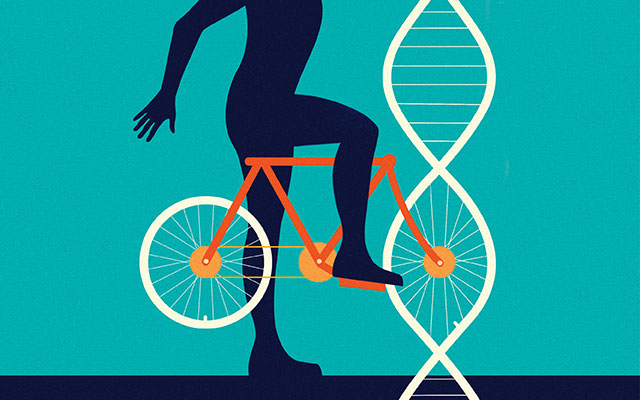Editors’ note: For more than 15 years, celebrated author and pioneering medical visionary Mark Hyman, MD, has been practicing and promoting a revolutionary healthcare concept known as functional medicine. It’s a patient-centered (vs. disease-centered) approach that focuses on identifying and addressing the root causes of chronic health challenges as opposed to merely treating symptoms. Functional medicine also emphasizes incorporating nutrition and lifestyle solutions rather than relying exclusively on pharmaceutical and surgical interventions. Experience Life is proud to bring you this six-part series in which Dr. Hyman describes the emerging practice of functional medicine and explains how it can improve your well-being.
When patients ask me if they are doomed by their genetic report card — destined to suffer the same diseases as their forebears — I tell them the story of the Pima Indians.
For centuries, the Arizona band of Pima Indians was thin, fit and healthy. Since the 1950s, however, they have become one of the world’s fattest populations. They have a staggeringly high 80 percent rate of diabetes and a life expectancy of just 46 years. In contrast, the band of Pima Indians who live in Mexico is still thin and fit, with no incidence of diabetes at all. These people are genetically identical to their cousins across the border, but the state of their health couldn’t be more different.
So what gives? As it turns out, the Mexico Pimas have been living much the same healthy lifestyle as their ancestors, while the Arizona Pimas have fallen victim to what we call the “White Menace” — a diet replete with white flour, white sugar and white fat (think shortening or trans fat).
The upshot? Genes may load the metabolic gun, but when it comes to creating real damage, it’s the environment that pulls the trigger.
Although your individual genes may make you more susceptible to some diseases, your DNA is not a fixed blueprint. Emerging research shows that your genes may be influenced by environmental factors such as diet (as in the case of the Pimas); stress; exercise; toxins in food, air and water; electromagnetic radiation; and trauma.
The great news is that by improving these environmental inputs, we can change the way our genes are activated and expressed. In other words, we may not be able to change our genotype (our actual genes), but we can change our phenotype (how our environment interacts with our genes to create who we are at this moment).
Making Medicine ‘Functional’
Many doctors cling to the myth of genetic determinism and, as a result, turn a blind eye to the environmental and lifestyle factors that underlie every disease. When a patient tells me, “It runs in my family,” I ask, “What runs in your family? Heart disease? Insulin resistance? Certain lifestyle habits? Was yours a family that was stressed out, didn’t exercise and ate pork rinds for breakfast?”
The question is: What really runs in the family — habits or genes — and what are you willing to do about it?
America’s broken healthcare system is based on outdated ideas that don’t address the roots of illness, a particularly dangerous situation given the country’s current epidemic levels of chronic disease. At present, 109 million Americans (more than a third of the population) suffer from a chronic disease, such as diabetes, cancer, heart disease, and autoimmune disorders like rheumatoid arthritis and fibromyalgia.
What really runs in the family — habits or genes — and what are you willing to do about it?
Conventional medicine is good at naming diseases, blaming the name for the problem and then finding a drug that matches the name. I call this the “naming and blaming” game, and in my mind, it’s a totally dysfunctional way of practicing medicine.
Given the number of people who are now suffering from chronic disease, it’s clear to me and a growing number of medical professionals that naming and blaming just isn’t good enough. We need to understand that diseases are not mysterious things that you catch or that just “show up” out of the blue, but are, instead, a product of how our environment interacts with our genes. The truth is, nearly all of the disease-related deaths in our society could be prevented.
I am part of a revolution in medicine that is helping to shift our scientific model of disease. This innovative healthcare approach is called functional medicine. It looks at the roots of illness — not just the symptoms — and works with the underlying biological forces that power our vitality (see “The 7 Keys to UltraWellness,” below).
So, for example, in the case of the Arizona Pima Indians, instead of simply treating the diabetes, functional medicine takes a broader look at the various nutrition and lifestyle factors that give rise to diabetes.
Take note: This is not alternative or integrative medicine, but rather a science-based, fundamental change in the way we think about health and disease.
Functional medicine provides a way of understanding all the influences on our biology, including those that are at the root of illness, and how our lifestyle and environment interact with our genes to create the balances or imbalances that are the real determinants of health or disease.
Functional medicine’s treatments are grounded in nutrition and lifestyle improvements that minimize imbalances and irritations while maximizing vitality. Most important, the treatments are patient-centered as opposed to disease-centered, meaning that not everyone with the same set of symptoms or same disease “name” will be treated the same way.
As the great William Osler, one of the founding fathers of modern medicine, said, “It is much more important to know what sort of a patient has a disease than to know what kind of a disease a patient has.” [For related perspectives on medicine and health, see “A New View of Health”.]
DNA Isn’t Destiny
Although a few traits — gender, race and hair color, for example — are controlled by a single gene and cannot be changed, most of our physical and biochemical characteristics are controlled by multiple genes. Our height and weight, metabolism, and most illnesses are affected by many different genes in concert with our environment.
The truth is, we all enjoy a tremendous opportunity to affect the expression of our genes — as well as our traits, tendencies and overall health — by improving both our physical environment and our cellular environment through more healthful diet and lifestyle choices.
There has been a great deal of excellent research that accentuates this point. In one Scandinavian study, for example, researchers assessed more than 44,000 pairs of identical twins to determine whether cancer was genetic. The result? Fewer than 10 percent of cancers could be traced to genetic predisposition; the rest were predominately environmental in origin, resulting from lifestyle choices such as diet and personal habits. (Only breast, prostate, stomach, lung and colon cancers showed a significant hereditary inclination.)
The same is true of other diseases. Let’s say you were born with a genetic tendency for heart disease. Meanwhile, you smoke, don’t exercise, eat poorly, gain weight and are under a lot of stress. Taken together, these factors strongly suggest that you are likely to develop heart disease at an early age. Yet, if you had the same genetic tendency for heart disease, but avoided smoking, exercised regularly, ate well, maintained your weight, and took steps to reduce and manage your stress, you would quite likely prevent heart disease from ever developing.
Or take the recent study in which Finnish researchers gave two groups of people with metabolic syndrome, or prediabetes, a slightly different diet. For 12 weeks, each group ate the same number of calories and the same amount of fat, protein, carbohydrates and fiber. The only difference? The first group had wheat, oat and potatoes as its carb source, and the second group had rye — which has very special properties because the body slowly absorbs it, and its phytonutrients help you lose weight and improve metabolism.
So what happened? The wheat, oat and potatoes diet activated 62 genes that increased inflammation and oxidative stress, worsened the blood-sugar balance, and generally amplified all the forces in the body that can lead to obesity, heart disease, cancer, diabetes and Alzheimer’s disease.
It was a 100 percent effect: No good genes were turned on. The rye diet, on the other hand, activated 71 genes that prevent diabetes, lower cholesterol, reduce inflammation and improve blood-sugar control — a 100 percent good gene effect.
Just imagine: If there were a drug that could turn off all the disease-promoting genes and turn on all the health-promoting, anti-aging genes, it would be a blockbuster. But you don’t see ads on television telling you to eat more whole-kernel rye bread!
Don’t Be Trigger-Happy
Most of our genes developed when we were eating a very different diet of whole, wild, fresh, real food and lived in a world without toxins like mercury and pesticides. In other words, our present-day genes were designed to thrive in a much more pristine world. Faced with present-day challenges — including a nutrient-deficient diet, a sedentary lifestyle and a profusion of environmental toxins — those same genes can become easily confused and disrupted.
Although much-ballyhooed genetic testing can be a helpful guide in understanding the origins and the risks of some chronic illnesses, we have to recognize that it is the interplay of many genes interacting with the environment and our daily choices that determines our health.
In reality, mutations in a single gene that we’re powerless to change cause less than 1 percent of all diseases, and these are rare disorders like cystic fibrosis and Tay-Sachs. We also know that there is no single gene for Alzheimer’s or depression or heart disease or cancer or autism. So we must give up the myth that our genes are entirely to blame. Instead, we must acknowledge that there are common variations in the symphony of our gene patterns that are integral to many chronic diseases — patterns that vary from person to person and are highly influenced by diet, toxins, allergens, infections and stress.
That’s actually wonderful news, because it means we can work to correct the environmental inputs and, in so doing, relieve the burden of suffering from so many chronic diseases. In future articles in this series (see links to each article at the end of this piece), I’ll be offering lots of examples of how you can begin transforming your own health profile through better health habits and choices.
In the meantime, remember this: However your genetic gun might be loaded, you’re under no obligation to pull the trigger by making unwise choices. Nor should you just wait around passively accepting the suppression of symptoms that passes for “treatment” of many of today’s most common chronic health problems.
Instead, I suggest making sure your “safety” switch is on, starting now. See “Recipe for Health,” below, for an overview of the choices that matter most. Then tune in to the rest of this series to learn more about how they work together — and why they matter so much in creating a health destiny you can feel good about.
Recipe for Health
Environmental factors like toxins, allergens, infections, stress and poor diet interact with your genes to create nearly all illnesses. Your vulnerability to a particular illness depends on how your genes interact with specific triggers.
Want to bring out the best in your genes and remove the irritants that encourage them to misbehave? Start living clean and healthy, and put vitality-supporting priorities like these at the very top of your “must have” list.
- Whole, real, fresh foods
- Nutrients (vitamins, minerals, etc.)
- Oxygen
- Water
- Light
- Sleep
- Healthy life rhythms
- Deep relaxation and rest
- Connection, community, love
- Meaning and purpose
The 7 Keys to UltraWellness
Simply put, when your core systems are out of balance, they make fertile ground for the roots of illness. When they are in balance, they become the keys to creating wellness and vitality:
- Environmental Inputs (diet, lifestyle, toxins, stress and trauma)
- Inflammation and Immune Balance (the hidden fire within)
- Hormone and Neurotransmitter Balance (insulin, thyroid, adrenal balance, sex hormones and mood chemicals)
- Gut and Digestive Health (digestion, absorption, assimilation, intestinal ecosystem and the gut-immune system)
- Detoxification Imbalances and Function (getting rid of wastes and dealing with toxins)
- Creating Energy (the source of life energy and metabolism — antioxidant balance)
- Mind-Body/Body-Mind Connection (change your mind, change your body; change your body, change your mind)
Learn more about the fundamentals of functional wellness by reading the other articles in this six-part series:



This Post Has 0 Comments